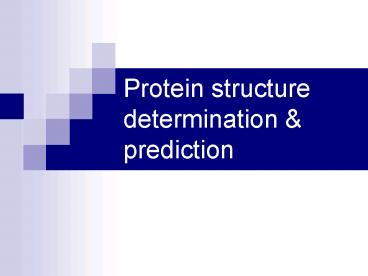Protein structure determination PowerPoint PPT Presentation
1 / 18
Title: Protein structure determination
1
Protein structure determination prediction
2
Tertiary protein structure protein folding
Three main approaches 1 experimental
determination (X-ray crystallography,
NMR) 2 Comparative modeling (based on
homology) 3 Ab initio (de novo) prediction
(Dr. Ingo Ruczinski at JHSPH)
3
Experimental approaches to protein structure
1 X-ray crystallography -- Used to determine
80 of structures -- Requires high protein
concentration -- Requires crystals -- Able to
trace amino acid side chains -- Earliest
structure solved was myoglobin 2 NMR --
Magnetic field applied to proteins in
solution -- Largest structures 350 amino acids
(40 kD) -- Does not require crystallization
4
Steps in obtaining a protein structure
Target selection
Obtain, characterize protein
Determine, refine, model the structure
Deposit in database
5
X-ray crystallography
- http//en.wikipedia.org/wiki/X-ray_diffraction
Sperm Whale Myoglobin
6
(No Transcript)
7
(No Transcript)
8
Nuclear magnetic resonance spectroscopy
http//en.wikipedia.org/wiki/Nuclear_magnetic_reso
nance
9
(No Transcript)
10
(No Transcript)
11
(No Transcript)
12
Article
13
Ab initio protein prediction
- Starts with an attempt to derive secondary
structure from the amino acid sequence - Predicting the likelihood that a subsequence will
fold into an alpha-helix, beta-sheet, or coil,
using physicochemical parameters or HMMs and ANNs - Able to accurately predict 3/4 of all local
structures
14
Secondary structure prediction
Chou and Fasman (1974) developed an
algorithm based on the frequencies of amino acids
found in a helices, b-sheets, and
turns. Proline occurs at turns, but not in a
helices. GOR (Garnier, Osguthorpe, Robson)
related algorithm Modern algorithms use
multiple sequence alignments and achieve higher
success rate (about 70-75)
Page 279-280
15
(No Transcript)
16
(No Transcript)
17
Fold recognition (structural profiles)
- Attempts to find the best fit of a raw
polypeptide sequence onto a library of known
protein folds - A prediction of the secondary structure of the
unknown is made and compared with the secondary
structure of each member of the library of folds
18
Threading
- Takes the fold recognition process a step
further - Empirical-energy functions for residue pair
interactions are used to mount the unknown onto
the putative backbone in the best possible manner

